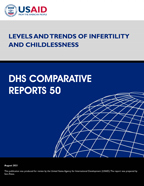There is no printed copy available to order.
Abstract:
Infertility is a significant reproductive
health issue for couples worldwide. The
effects of infertility are wide-ranging¬¬—
from mental health issues such as anxiety
and depression to social issues such as
ostracization, intimate partner violence,
and divorce. Although infertility affects
both men and women, the woman in a couple
is most often blamed for the inability to
bear children. Despite its importance,
infertility is understudied and there are
no standard definitions for estimating
prevalence.
This study aims to update estimates of
childlessness, primary infertility, and
secondary infertility in 16 USAID PRH
focus countries and compare those
estimates to previous estimates. Three of
four rounds of DHS survey data were
compared. Levels of infertility were
calculated using a previously tested
demographic approach that incorporates
desire for a child into the definition to
distinguish infertility from voluntary
childlessness. In addition, this approach
adjusts for incomplete information on
contraceptive use arising from non-use of
the contraceptive calendar. In most
countries, childlessness, defined as never
given birth, as measured among women in
the 40-44 age group, was low and has
decreased slightly, with an average of
1.9% in the first round of surveys and
1.7% in the most recent round. Estimates
of primary infertility were low, with
ranges from 0.9% in Kenya to 2.9% in Mali
in the first round of surveys, and from
0.3% in Kenya to 3.8% in Senegal in the
last round. Primary infertility estimates
stayed relatively stable over time.
Estimates of secondary infertility were
higher, with ranges from 8.0% in Rwanda to
25.7% in India in the first round of
surveys, and from 5.5% in Kenya to 36.8%
in Bangladesh in the most recent round of
surveys. Secondary infertility estimates
also stayed stable in most countries,
although consistent increases were seen in
Bangladesh and Nepal, and consistent
decreases in Kenya.
Concurrent trends in other health or
environmental factors may be contributing
to these trends in infertility, as well as
increasing availability of assisted
reproductive technologies in many parts of
the world. Even with plateauing or
decreasing levels of infertility, the
impact of infertility on couples around
the world is significant. Where secondary
infertility is high or increasing,
research into factors that account for
these patterns needs to be undertaken to
identify appropriate interventions.
Further work into how to improve access to
infertility care and management programs
is required.
 Levels and Trends of Infertility and Childlessness (PDF, 1758K)
Levels and Trends of Infertility and Childlessness (PDF, 1758K)
 Levels and Trends of Infertility and Childlessness (CR50) and Correlates of Secondary Infertility (AS79) - Analysis Brief
Levels and Trends of Infertility and Childlessness (CR50) and Correlates of Secondary Infertility (AS79) - Analysis Brief
